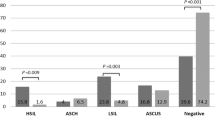Abstract
A central role in anal carcinogenesis of high-risk types of human papillomaviruses (hrHPV) was recently established, but the possible role of benign anal lesions has not been addressed in hrHPV-positive and -negative anal cancers. As part of a population-based case-control study in Denmark and Sweden, we interviewed 417 case patients (93 men and 324 women) diagnosed during the period 1991-94 with invasive or in situ anal cancer, 534 patients with adenocarcinoma of the rectum and 554 population controls. Anal cancer specimens (n = 388) were tested for HPV by the polymerase chain reaction. Excluding the 5 years immediately before diagnosis, men, but not women, with anal cancer reported a history of haemorrhoids [multivariate odds ratio (OR) 1.8; 95% confidence interval (CI) 1.04-3.2] and unspecific anal irritation (OR 4.5; CI 2.3-8.7) significantly more often than controls. Women with anal cancer did not report a history of benign anal lesions other than anal abscess to any greater extent than controls, but they had used anal suppositories more often (OR 1.5; CI 1.1-2.0). Patients with hrHPV in anal cancer tissue (84%) and those without (16%) reported similar histories of most benign anal lesions, but anal fissure or fistula was more common among hrHPV-positive cases. Ulcerative colitis and Crohn's disease, reported by <1% of study participants, were not associated with anal cancer risk. The higher proportion of hrHPV-positive anal cancers among case patients with anal fissure or fistula suggests that such mucosal lesions may provide direct viral access to basal epithelial layers. Since risk associations with benign anal lesions in men may be confounded by unreported sexual behaviour, and since risk associations in women were generally negative, it seems unlikely that benign anal lesions act as promoters in hrHPV-associated anal carcinogenesis. Moreover, benign anal lesions appear not to be linked to an alternative, hrHPV-unassociated causal pathway to anal cancer. Ulcerative colitis and Crohn's disease were not supported as causal factors for anal cancer.
This is a preview of subscription content, access via your institution
Access options
Subscribe to this journal
Receive 24 print issues and online access
$259.00 per year
only $10.79 per issue
Buy this article
- Purchase on Springer Link
- Instant access to full article PDF
Prices may be subject to local taxes which are calculated during checkout
Similar content being viewed by others
Author information
Authors and Affiliations
Rights and permissions
About this article
Cite this article
Frisch, M., Glimelius, B., van den Brule, A. et al. Benign anal lesions, inflammatory bowel disease and risk for high-risk human papillomavirus-positive and -negative anal carcinoma. Br J Cancer 78, 1534–1538 (1998). https://doi.org/10.1038/bjc.1998.719
Issue Date:
DOI: https://doi.org/10.1038/bjc.1998.719
This article is cited by
-
Anal Neoplasia in Inflammatory Bowel Disease Is Associated With HPV and Perianal Disease
Clinical and Translational Gastroenterology (2016)
-
Carcinoma arising in enterocutan fistulae of Crohn's disease patients: description of two cases
International Journal of Colorectal Disease (2006)
-
HPV in anal squamous cell carcinoma and anal intraepithelial neoplasia (AIN)
International Journal of Colorectal Disease (2006)
-
High prevalence of anal squamous intraepithelial lesions and squamous-cell carcinoma in men who have sex with men as seen in a surgical practice
Diseases of the Colon & Rectum (2001)
-
Viral infections of the gastrointestinal tract
Current Gastroenterology Reports (1999)



